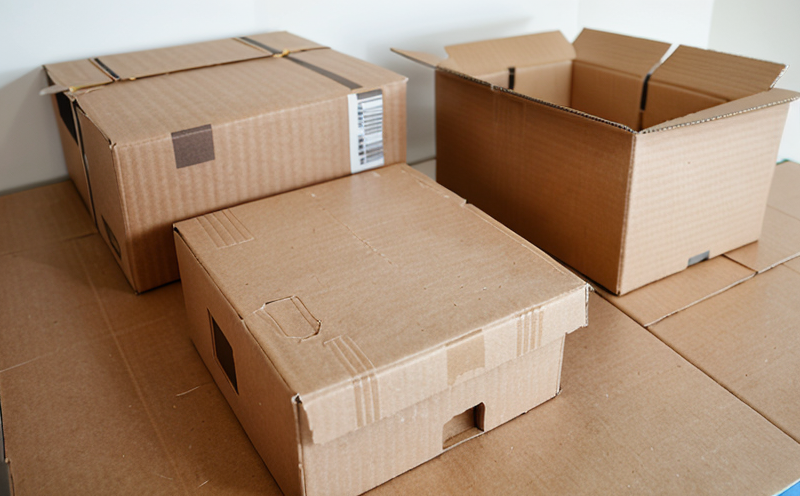ISO 2758-2 Burst Index under Environmental Conditions
The ISO 2758-2 standard specifies the method of determining the burst index of paper and cardboard packaging materials under defined environmental conditions. This test is crucial for ensuring that the packaging can withstand the pressures it will encounter during transportation, handling, and storage without compromising its integrity.
Burst testing is a key component in the overall quality assurance process for packaging materials. It evaluates the material's ability to resist sudden pressure applied from inside the package. This test is particularly important when dealing with paper or cardboard that may be subjected to various environmental conditions, such as temperature fluctuations and humidity levels.
The burst index measurement provides a quantitative assessment of the material's strength under specific environmental stress conditions. The test involves subjecting the specimen to increasing pressure until it bursts. The burst index is measured in kilopascals (kPa) or pounds per square inch (psi). Understanding this metric helps manufacturers and quality control teams ensure that their packaging meets both regulatory requirements and customer expectations.
The environmental conditions under which the test is conducted play a critical role in assessing the material's performance. These include temperature, humidity, and pressure variations that mimic real-world scenarios. For instance, testing under high-temperature and high-humidity conditions can help identify potential weaknesses in the packaging design that might not be apparent under normal storage conditions.
Accurate specimen preparation is essential for obtaining reliable test results. This involves cutting the paper or cardboard into standard dimensions as specified by ISO 2758-2. The samples should be conditioned to ensure they are at a stable moisture content before testing, typically over a period of 48 hours in an environmental chamber set to the required conditions.
The burst tester used for this test is specifically designed to apply controlled pressure uniformly across the sample's surface until it fails. The machine should be capable of applying pressures up to the specified upper limit of the burst index range being tested, usually 100 kPa or higher.
After the test, the burst index is calculated based on the maximum pressure applied before failure. This value represents the material's resistance to internal pressure under specific environmental conditions and provides valuable insights into its suitability for various applications.
- Environmental Conditions: Temperature (e.g., 23°C ± 2°C), relative humidity (e.g., 50% ± 5%), and atmospheric pressure are critical factors that influence the burst index measurement. These conditions simulate real-world storage and transportation environments.
- Samples Preparation: Standardized cutting, conditioning, and handling of specimens ensure consistency in test results, thereby enhancing the reliability of the measurements.
- Burst Testing Apparatus: The instrument must be capable of applying pressure uniformly across the sample surface to prevent localized failure. This ensures accurate burst index readings.
Frequently Asked Questions
Quality and Reliability Assurance
Burst testing is a cornerstone of quality assurance processes in the packaging industry. By ensuring that paper and cardboard materials meet specified burst index requirements, manufacturers can enhance product reliability and customer satisfaction. This test helps identify potential weaknesses in material design early on, allowing for timely adjustments to improve performance.
Consistent adherence to ISO 2758-2 standards ensures that all packaging meets the same rigorous quality benchmarks. This uniformity is essential for maintaining brand consistency across different products and markets. Compliance with international standards like ISO provides a benchmark of excellence, which can be leveraged in marketing and sales strategies.
Quality assurance teams rely on accurate burst index measurements to monitor product performance over time. Regular testing helps detect any deviations from expected performance levels, enabling proactive measures to address issues before they escalate into larger problems. This approach fosters a culture of continuous improvement within the organization.
Environmental and Sustainability Contributions
Incorporating environmental considerations into packaging design is not only beneficial for the ecosystem but also advantageous for businesses looking to reduce their carbon footprint. Burst testing under various environmental conditions helps identify materials that are both robust and sustainable.
Paper and cardboard are inherently renewable resources, making them an attractive choice for eco-conscious consumers. By ensuring that these materials meet stringent burst index requirements, manufacturers can promote the use of environmentally friendly packaging solutions without sacrificing product protection.
The ability to withstand high pressures under environmental stress conditions demonstrates a material's durability and resilience. This quality is particularly important in industries where products must travel long distances or be stored for extended periods. Using sustainable materials that pass burst testing ensures that the packaging remains effective throughout its lifecycle, reducing waste and promoting circular economy principles.
Competitive Advantage and Market Impact
Meeting stringent quality standards like ISO 2758-2 can provide a significant competitive edge in the market. Consumers are increasingly demanding sustainable, high-quality packaging solutions that protect products while minimizing environmental impact. Companies that invest in testing under various conditions demonstrate their commitment to excellence and sustainability.
A reputation for producing reliable and environmentally friendly packaging materials enhances brand image and customer trust. This can lead to increased sales and market share as consumers prefer brands that align with their values of sustainability and quality.
Companies that integrate burst testing into their quality control processes are better positioned to respond to changing regulatory requirements and consumer preferences. By staying ahead of the curve, they can anticipate future trends and adapt their offerings accordingly, maintaining a competitive edge in an ever-evolving market landscape.





